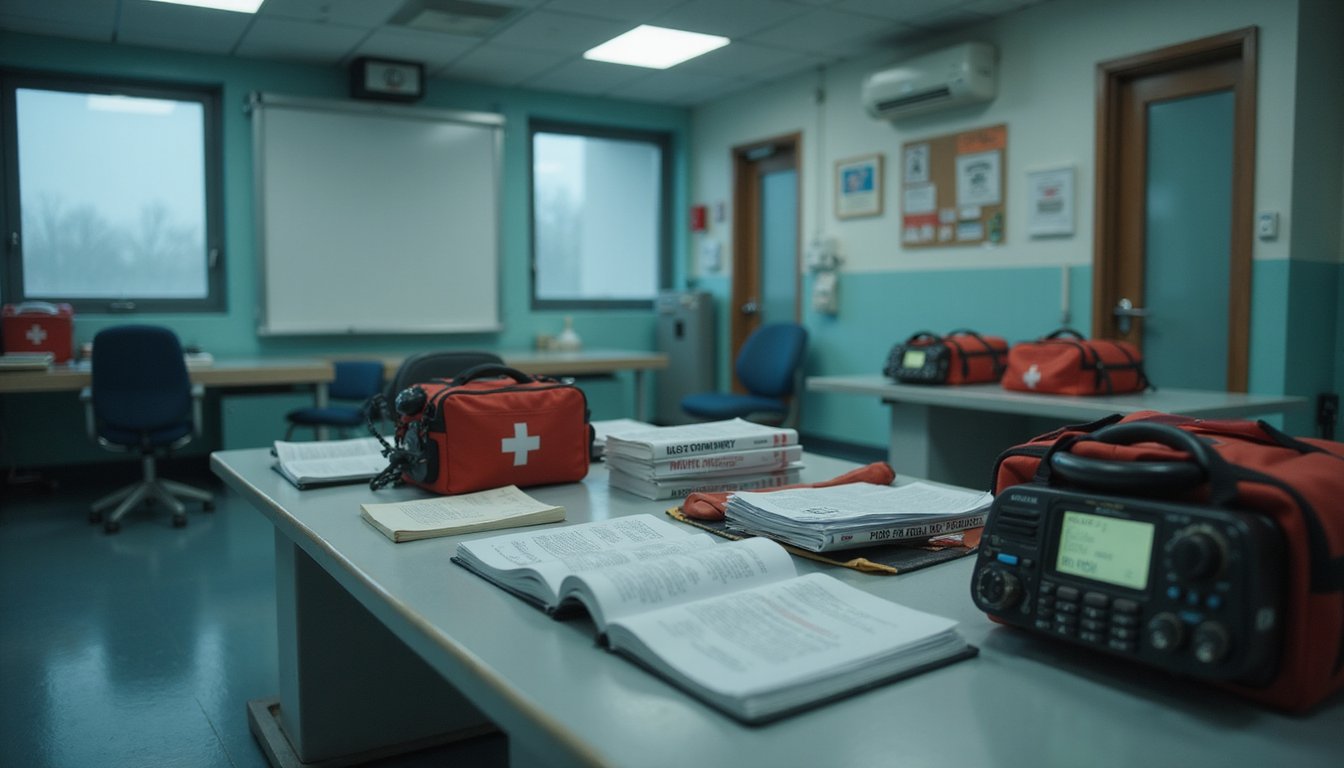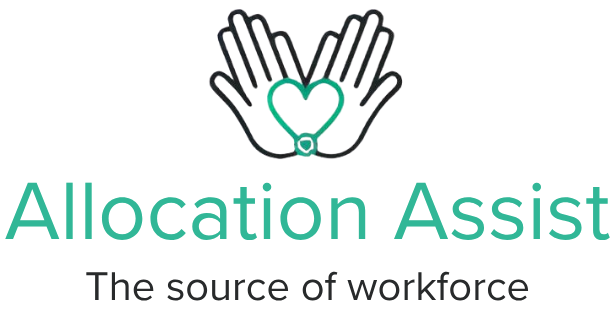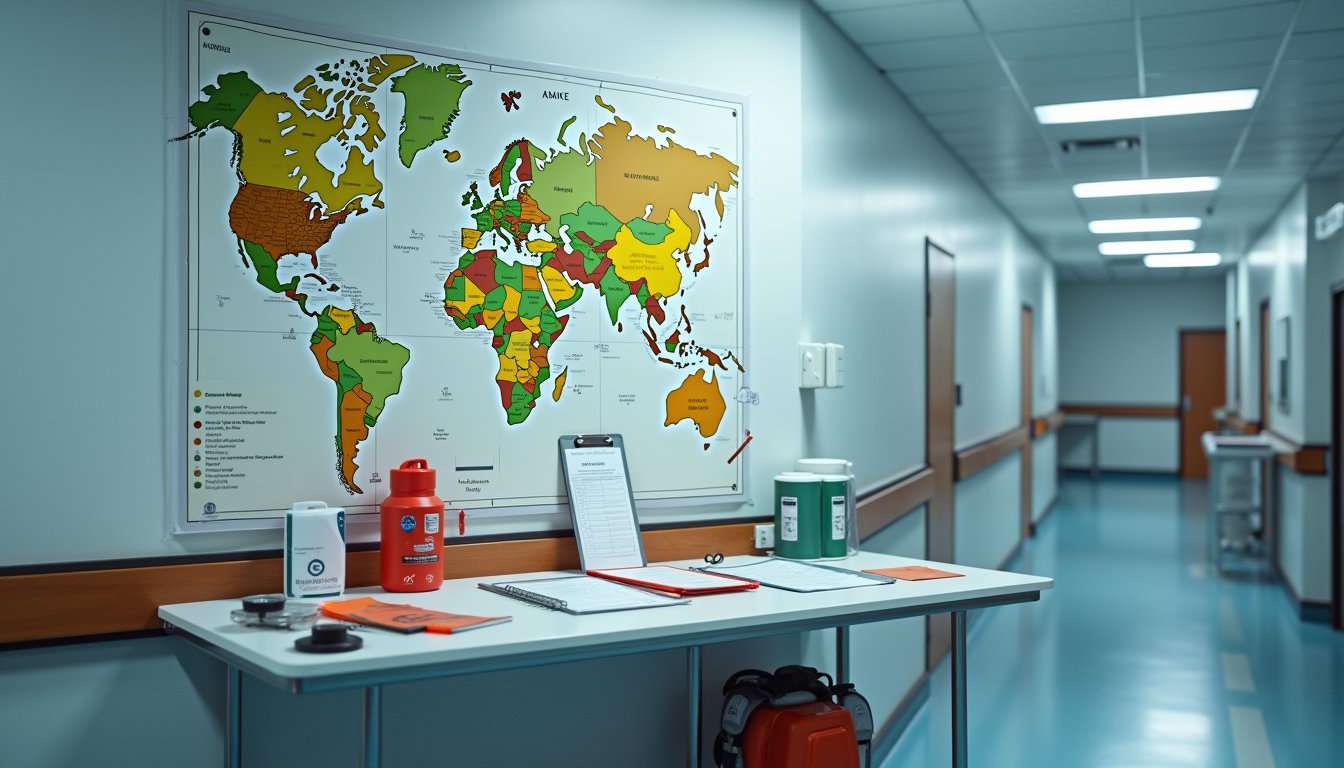Healthcare safety protocols require your strict adherence to established standards for patient and staff protection. You’ll need to follow OSHA guidelines, maintain HIPAA compliance, and participate in regular safety training that covers incident reporting, violence prevention, and emergency response procedures. You must document all safety events, conduct risk assessments, and guarantee proper communication during shift changes. Understanding these thorough protocols will strengthen your facility’s safety culture and regulatory compliance.
Essential Components of Leadership Support in Healthcare Safety

While healthcare organizations face numerous operational challenges, effective leadership support remains the cornerstone of maintaining robust safety protocols. You’ll find that successful safety culture implementation requires clear policy statements and defined leadership accountability across all management levels. Safety behavior modeling by executives sets a powerful example for staff to follow. Open communication channels promote collaborative dialogue between teams to enhance overall patient care quality. Promoting psychological safety enables healthcare workers to express concerns without fear of retribution.
Your organization’s leadership must establish multidisciplinary safety committees to monitor systemic risks and guarantee transparent decision-making processes for resource allocation. It’s vital to implement standardized reporting channels that enable staff to voice concerns without fear of retaliation. Leaders should demonstrate their commitment through regular safety briefings and performance tracking linked to organizational goals.
To strengthen safety culture, you’ll need to make certain leadership provides adequate financial and operational support for safety initiatives while maintaining transparency in resource distribution and investment decisions. This thorough approach helps create a resilient safety framework.
Risk Assessment and Incident Reporting Systems
Your organization’s risk assessment framework must integrate standardized incident reporting protocols across all departments to guarantee consistent documentation and rapid response capabilities. You’ll need to implement real-time monitoring systems that can detect and alert staff to potential threats before they escalate into serious safety incidents. Cross-departmental safety documentation should follow ISO 27001 guidelines while maintaining compliance with HIPAA requirements, enabling systematic tracking of adverse events and corrective actions. Modern data integration enables proactive prevention of incidents through comprehensive analysis of safety trends. The implementation of streamlined security processes helps healthcare facilities improve operational efficiency while reducing manual documentation efforts across safety protocols. Regular evaluation of compliance training programs ensures that staff members maintain proper risk awareness and understand their roles in maintaining safety standards.
Standardized Reporting Best Practices
Effective healthcare safety protocols depend on systematic approaches to risk assessment and standardized incident reporting mechanisms. You’ll need to implement extensive reporting frameworks that enable consistent documentation and analysis of safety events. These frameworks should incorporate structured processes for identifying, evaluating, and addressing potential risks. Leveraging comprehensive HRA data helps identify specific risk factors that may be missed during routine assessments. Establishing a safe reporting culture where staff can freely communicate concerns without fear of retaliation is essential for maintaining effective safety protocols.
You must establish clear incident tracking procedures that allow you to monitor outcomes and update risk mitigation strategies accordingly. This includes applying appropriate controls, measuring their effectiveness, and adjusting approaches based on collected data. Your reporting system should facilitate both proactive risk assessments and reactive incident documentation, ensuring you’re capturing critical safety information across all operational areas. Organizations should utilize methods derived from high-reliability industries to enhance their risk management capabilities. Regular review and refinement of these processes will help maintain regulatory compliance while strengthening your organization’s overall safety culture.
Real-Time Threat Identification
Modern healthcare environments require sophisticated real-time threat identification systems that integrate automated detection mechanisms with AI-driven monitoring capabilities. You’ll find these systems employ passive detection methods and smart machine learning to correlate vulnerabilities without disrupting critical medical operations. Real-time monitoring enables timely threat resolution through immediate IT team notifications. The platform’s foundational model autonomously adapts to detect emerging security threats. Continuous learning helps systems adapt to new behavioral patterns and enhance overall security measures.
Your threat monitoring processes benefit from edge computing that enables real-time interventions with 94.3% success rates, while behavioral analysis identifies unauthorized access attempts and data anomalies. Through vulnerability assessment protocols, you’re able to leverage predictive analytics that anticipate security weaknesses across healthcare IT infrastructures.
You’ll maintain HIPAA compliance through blockchain-enabled audit trails and automated documentation. The system’s federated learning approach enhances privacy while reducing false positives by 70%, ensuring you’re alerted only to legitimate threats that require immediate attention.
Cross-Department Safety Documentation
While healthcare organizations endeavor for seamless documentation workflows, cross-department safety protocols require standardized integration of Continuity of Care Document (CCD) frameworks and interface engines with built-in redundancy. A team-centered approach strengthens documentation accuracy and safety protocols across departments. Daily safety huddles ensure real-time communication of potential risks and concerns between shifts. Failure modes and effects analysis helps teams identify potential system failures before implementing new procedures. You’ll find that documentation standardization across departments relies heavily on encrypted data transmission and anchored EHR workflows to maintain information integrity.
Cross department collaboration becomes more effective when you implement standardized templates for transfer reports and automated social determinants of health (SDoH) capture. You must guarantee interface documentation validates data exchange between EHRs and ancillary systems, while maintaining secure transmission protocols for cross-department transfers. By aligning workflow steps from pre-admission through discharge, you’ll create consistent documentation patterns that support systematic risk identification and reporting across all healthcare settings.
Violence Prevention Measures and Security Controls
Healthcare organizations must implement extensive violence prevention measures and security controls to address the alarming rate of workplace incidents, where 73% of nonfatal violent injuries affect healthcare workers. You’ll find preventive strategies integrated across multiple levels, from engineering controls to administrative protocols, with security innovations targeting high-risk areas.
In outpatient clinics, where 34.8% of incidents occur, you’ll need enhanced visitor management systems and screening protocols. Emergency departments require panic buttons and continuous security monitoring. You must enforce zero-tolerance policies for all staff, patients, and visitors while ensuring proper documentation of incidents through standardized reporting systems. Regular hazard assessments will help you identify potential triggers like patient agitation or environmental stressors, allowing for proactive intervention and risk mitigation through the Building a Safer Workplace framework. The implementation of an emergency white code ‘1111’ system enables healthcare workers to quickly alert security and administration when violent incidents occur.
Emergency Response and Staff Training Programs

Emergency response readiness requires you to master an extensive set of crisis protocols, including evacuation procedures and communication systems that align with CMS mandates. You’ll need to participate in regular training drills focused on de-escalation techniques and medical countermeasures, with documented completion rates tracking your proficiency across FEMA’s preparedness capabilities. Your facility must conduct after-action assessments following both simulated and actual emergency activations to identify gaps in staff performance and refine response protocols accordingly.
Staff Crisis Response Preparation
Modern healthcare facilities must implement thorough staff crisis response protocols that align with CMS regulations and WHO guidelines for emergency preparedness. You’ll need to participate in mandatory ICS training modules and quarterly emergency response drills that test your staff communication and resource allocation skills during crisis scenarios.
Your facility’s written disaster plans will guide you through medical countermeasure distribution, evacuation procedures, and surge capacity management. You’re required to engage in simulated real-world scenarios that integrate dual-use protocols across multiple hazard types. During these drills, you’ll practice interagency coordination with EMS partners and utilize information-sharing platforms for real-time data exchange. Your performance in these exercises helps identify response gaps through annual after-action reports, ensuring continuous improvement in crisis preparedness.
Essential De-escalation Training Methods
While managing aggressive behavior remains a critical challenge in clinical settings, extensive de-escalation training programs have demonstrated measurable improvements in staff confidence and patient outcomes. You’ll need to master specific de-escalation techniques and communication strategies to effectively manage high-risk situations.
| Training Component | Key Techniques | Measured Impact |
|---|---|---|
| Active Listening | Reflective Communication | 61% Effectiveness Rate |
| Risk Assessment | Non-verbal Cues Detection | 40% Restraint Reduction |
| Cultural Sensitivity | Bias Recognition | Improved Trust Metrics |
| Crisis Prevention | Environment Management | Decreased Incidents |
Your training must incorporate validated assessment tools like CCPAI while focusing on proactive intervention methods. Maintain calm vocal modulation, practice non-confrontational body language, and employ collaborative problem-solving approaches. These evidence-based techniques have shown sustained confidence improvements up to 12 months post-training, with mean scores increasing from 43.2 to 59.9.
Emergency Protocol Practice Drills
Successful implementation of protocol practice drills requires a structured, evidence-based approach across multiple training methodologies. You’ll find operations-based drills dominate healthcare settings at 36%, while tabletop exercises account for 31% of training sessions. Current data shows drill effectiveness remains a concern, with 53.3% of participants reporting low impact.
To enhance scenario relevance, you must integrate multiple drill types, including function-oriented and thorough exercises. Your facility’s success depends on proper documentation, consistent masking protocols, and coordinated departmental responses. You’ll need to address common challenges, such as the 40% failure rate in critical tasks during unscheduled drills. Regular exercises, rather than annual events, prove essential for maintaining emergency preparedness. Verify your post-drill evaluations identify specific protocol gaps and actionable improvements.
Regulatory Compliance and OSHA Guidelines

As healthcare facilities adapt to evolving safety requirements, OSHA’s regulatory framework has established extensive guidelines for protecting workers and patients. You’ll need to stay current with regulatory updates, including enhanced hazard communication standards and stricter PPE protocols. These compliance challenges require your attention to new documentation requirements and increased penalty structures.
| Requirement | Your Action Required |
|---|---|
| PPE Fit Testing | Conduct mandatory tests quarterly |
| Chemical Labeling | Update to GHS standards |
| Infection Control | Implement enhanced ventilation |
| Documentation | Maintain detailed exposure records |
You must guarantee your facility meets updated Safety Data Sheet requirements and provides thorough staff training on chemical handling. The latest standards emphasize proper PPE fitting, particularly for diverse workforces, and mandate regular compliance audits. Your infection control measures must incorporate proactive decontamination routines and documented verification of PPE integrity.
Special Considerations for High-Risk Medical Units
High-risk medical units demand specialized safety protocols beyond standard OSHA requirements. You’ll need to implement thorough infection control measures, including single-patient rooms and strict PPE protocols for contact precautions. When working in these units, you must use higher filtration respirators like N99s or PAPRs for enhanced protection during high-risk procedures.
You’re required to follow specific protocols for shared equipment, particularly with blood collection devices and glucometers. Never reuse single-patient items, and maintain detailed cleaning documentation. In high-risk areas, you’ll need to verify proper ventilation systems with HEPA filtration and establish cohorted sections for infected patients. It is crucial to coordinate cross-functional workflows between clinical teams while maintaining consistent communication during shift changes to guarantee uninterrupted safety measures.
Frequently Asked Questions
How Often Should Healthcare Facilities Update Their Safety Protocols and Equipment?
You’ll need to conduct safety audits at varying frequencies based on protocol type. Update emergency preparedness plans every two years for general facilities and annually for long-term care. You must perform equipment maintenance according to NFPA 99 standards on a triennial basis. Your infection control protocols require monthly updates for vaccination data, while fire safety and hazardous materials procedures need revision every three years following regulatory cycles.
What Psychological Support Is Available for Staff Who Experience Workplace Violence?
You’ll have immediate access to trauma counseling and psychological first aid following any violent incident. Your facility must provide structured support groups and individual therapy sessions through specialized mental health professionals. You’re entitled to long-term cognitive-behavioral therapy and can participate in peer support networks. You’ll receive ongoing care through multidisciplinary teams, and you can access confidential external mental health resources through your organization’s provider network.
How Do Safety Protocols Differ Between Day Shifts and Night Shifts?
You’ll notice distinct shift dynamics between day and night protocols. During days, you’ll have robust staff communication channels with immediate access to response teams and specialists. At night, you’ll operate with heightened autonomy and modified reporting structures. You must follow stricter nurse-to-patient ratios during nights, while implementing enhanced monitoring protocols. Your documentation requirements remain consistent, but night shifts require additional verification steps for critical interventions.
What Role Do Patients’ Families Play in Workplace Safety Procedures?
You’ll find that family engagement notably enhances workplace safety through multiple channels. You can leverage families’ continuous presence for early detection of adverse events and monitoring of safety compliance. Through established communication strategies, you’ll enable families to participate in bedside shift reports and care transitions. You must recognize their role in enforcing infection control practices and identifying potential hazards. They’ll also strengthen accountability by participating in incident reporting processes.
How Are Safety Protocols Modified During Public Health Emergencies or Disasters?
During public health emergencies or disasters, you’ll see significant modifications to standard protocols through enhanced emergency preparedness measures. You must implement ICS structures, expedite procurement processes, and activate disaster response networks. You’ll need to intensify surveillance systems, modify staff deployment based on risk assessments, and strengthen multi-agency coordination. Additionally, you’re required to establish rapid communication channels and adjust stockpile management to guarantee adequate PPE and medical supplies.








